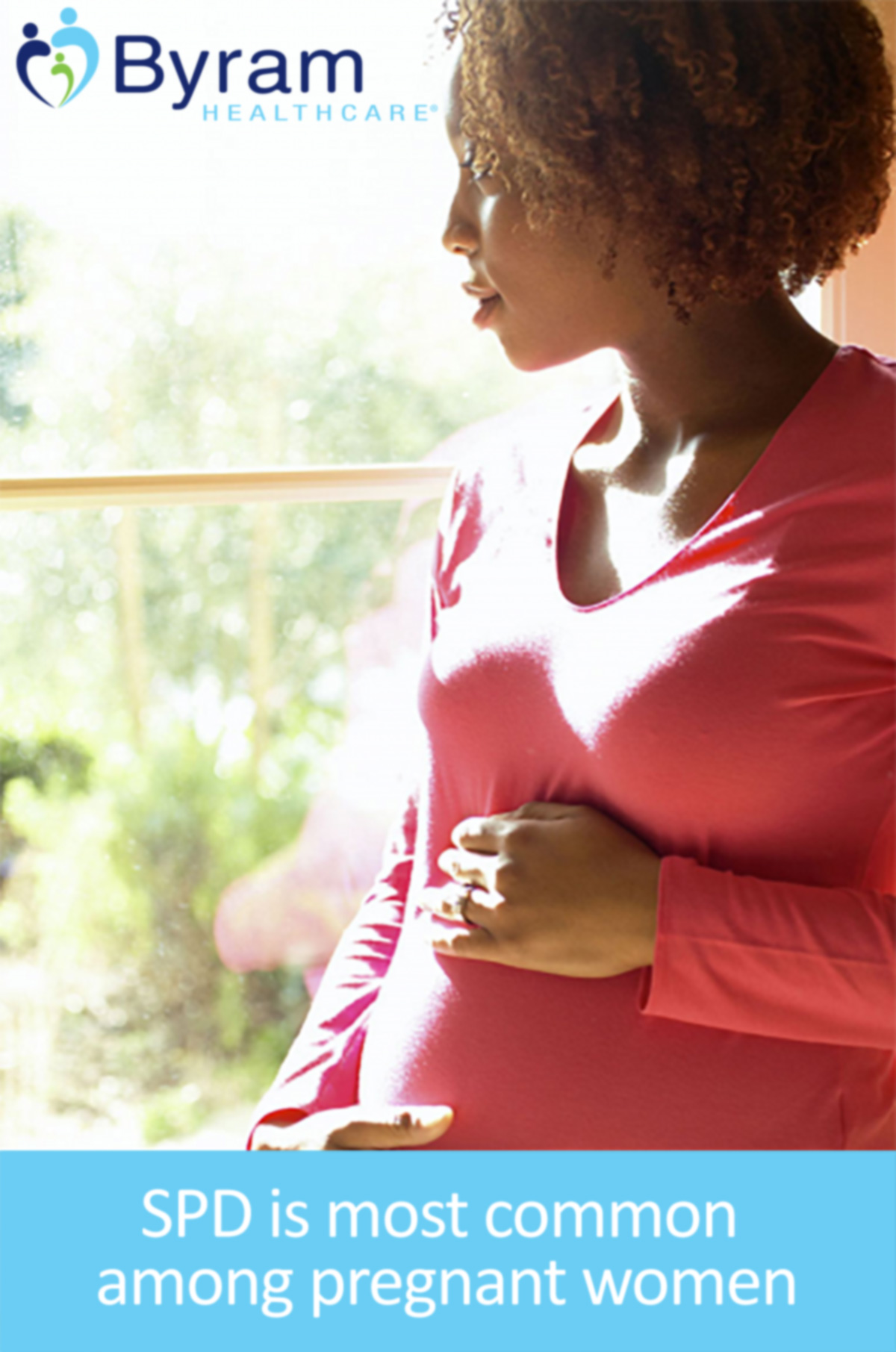What is Symphysis Pubis Dysfunction?
Symphysis Pubis Dysfunction (SPD) is a problem for approximately 1 in 300 pregnant women (although some experts say it’s as many as 1 in 50). Also known as Pelvic Girdle Pain (PGP), Symphysis Pubis Dysfunction is a condition that causes moderate to severe pain in the pubic area.
Your pelvis is constructed by two pubic bones that curve, forming a cradle shape. The two bones come together at a firm joint called the symphysis pubis, located in the front of your pelvis (see image below). The joint is made strong by dense ligaments.
What causes Symphysis Pubis Dysfunction?
Symphysis Pubis Dysfunction means that the ligaments keeping your pelvic bone aligned – normally tough and dense – become relaxed, too soon.
During pregnancy, your body produces the hormone relaxin. The hormone softens the ligaments, making it easier for your baby to pass through.
As delivery nears, things should be loosening up, making childbirth easier.
With SPD, this loosening or stretching happens too early during the pregnancy. As a result, it makes the joint unstable, causing pelvic pain and other odd sensations.
Symphysis Pubis Dysfunction or pelvic pain can be brought on by:
- the uneven movement of your pelvis
- changes in the way your muscles support your pelvic girdle joints
- one pelvic joint not working as it should, causing knock-on pain in the other joints nearby1
Who gets Symphysis Pubis Dysfunction? 
While SPD isn’t restricted only to pregnant women, women are more prone to the condition than men2. This condition can result from injury or arthritis but is most commonly experienced by pregnant women.
You are also more likely to develop SPD1 if:
- you have previously injured your pelvis
- you had pelvic girdle pain in a prior pregnancy
- you have experienced pelvic girdle pain or pelvic joint pain before pregnancy
- you have a high BMI and were overweight before pregnancy
What are the symptoms of Symphysis Pubis Dysfunction?
The symptoms and signs of SPD can present major obstacles, reducing your quality of life.
The most common symptom is intense pain in your pelvic area, described by some as ‘feeling as though your pelvis is tearing apart’ (ouch).
While the pain is focused mostly on the pubic region, some women also report feeling pain spread to the upper thighs and perineum.3
Another prominent symptom of SPD is difficulty walking. Pain can worsen when you are walking or doing any activity that requires you to bear weight (such as lifting one leg in front of the other to climb steps or put on a pair of pants). The difficulties SPD presents in walking often result in walking with a waddle.4
Aside from pelvic pain and difficulty walking, women with SPD may also feel or hear a clicking or grinding sound.
Symptoms of SPD can develop gradually or in a sudden onset. It may grow increasingly painful as your child grows, forcing the area to bear more weight.
Other symptoms of symphysis pubis dysfunction or pelvic girdle pain² are:
- pain in the lower back and/or hips when bending over
- lower back or hip pain when sitting or moving your legs apart
- lower back or hip pain when rolling over in bed
- pain in the pelvic region, back or hips during sex
Symphysis Pubis Dysfunction Diagnosis
As with all medical issues, the diagnosis of SPD requires a thorough examination by a trained medical professional. A doctor will look through your medical history and ask you a series of questions.
Tests such as an ultrasound may also be used to confirm the diagnosis.
Symphysis Pubis Dysfunction Treatment
Your treatment plan can vary depending on the symptoms you’re experiencing.
Physical therapy is recommended, as a physiotherapist can teach you relaxation exercises that can help to relieve pain. They will also test the stability, range of motion and pain in the region.

Other treatments can range from home remedies (ice pack) to acupuncture.
Pelvic support belts have also been reported as providing significant pain relief. A support belt helps align your pelvic bones and therefore must be custom fitted by your physiotherapist. These support belts can be worn during the day and at night.
Symphysis Pubis Dysfunction Relief
The methods of relief suggested below are not meant to take the place of medical attention. Above all else, you should take direction from medical professionals.
There are a lot of things you can do on your own to help relieve symptoms, strengthen the region and prevent issues from occurring.
• Lay on your side instead of your back
Laying on your side puts pressure on your belly instead of your pelvis and back. You can use a maternity pillow for extra support.
• Use pillows to support your lower back when sitting
Having a pillow supporting your lower back helps give the region a break, even if you are sitting the right way already.
• Avoid heels at all costs
Stick those heels in the back of your closet and don’t take them out until your baby has arrived. The extra strain wearing heels puts on the rest of your body is adding unnecessary strain. Just don’t do it, trust me.
• Don’t sit with your legs crossed
Sitting tailor-style as often as possible will take pressure off of the painful areas.
• Avoid riding a bike
If you’ve ever ridden a bike for a moderate amount of time, you already know. Even when perfectly healthy and not carrying a human life in your womb, riding a bike can be a pain in the posterior. If you were to ever hit a pothole with SPD you would have a new understanding of the word, ‘agony‘.
• Avoid highly straining movements and activities
This is already a good idea when having SPD in pregnancy. In the case of symphysis pubic dysfunction, you will especially want to avoid this extra strain.
• Learn a new way to roll over
Moving around during the third trimester can be quite a challenge. Laying down and rolling over in bed will introduce you to pressure and discomfort. Avoid the extra stress by learning the ‘pregnant roll over’. While not the cutest movement in the world, by trimester three you are probably done worrying about ‘cute’.
• Be extra cautious to avoid falls
Somewhat self-explanatory – falling is no good.
In order to reduce the chances you get tripped up:
- hold onto the handrails when climbing stairs
- sit down when getting dressed
- don’t carry anything when walking up stairs
- salt walkways, outdoor steps and other surfaces where ice may be present
- walk like a penguin, distributing weight and keeping balance
- always wear shoes with good traction and proper support (sorry, no flip flops)
- don’t carry anything excessive (put your significant other to work!) and carry items close to your body, avoiding extending your arms, when possible.
- Don’t stand up too quickly, reducing dizziness
- Snack regularly, eat healthy foods and drink lots of water!
Conclusion
Symphysis pubis dysfunction can be a painful, annoying condition that some of us pregnant women will deal with. However, don’t become frightened by this article. If you do have SPD, your body will repair itself post-birth, as your body stops producing the hormone relaxin.
LIKE ALWAYS, you don’t have to go through any aspect of pregnancy alone. Ask for help. Talk to your doctor. Share with friends. Eat healthy. Exercise lightly, but often. Drink a lot of water. And in the event you are experiencing pelvic pain, call your doctor!
To end on a positive note, all women (regardless of an SPD diagnosis) are eligible to receive an electric breast pump at no cost. Thank you, Affordable Care Act!
Select Your Insurance Covered Breast Pump Today
Sources:
-
http://www.babycentre.co.uk/a546492/pelvic-pain-spd
-
http://www.webmd.boots.com/pregnancy/guide/pelvic-girdle-pain-pgp-spd
-
http://www.whattoexpect.com/pregnancy/symptoms-and-solutions/symphysis-pubis-dysfunction
-
http://ptjournal.apta.org/content/85/12/1290
-
http://www.babycentre.co.uk/a546492/pelvic-pain-spd





